Blue Angels
| Blue Angels U.S. Navy flight demonstration squadron | |
|---|---|
 Blue Angels insignia | |
| Active | 24 April 1946–present |
| Country | |
| Branch | United States Navy |
| Role | Aerobatic flight demonstration team |
| Size | Navy: 13 officers Marine Corps: 4 officers Navy & Marine Corps: 100+ enlisted personnel |
| Garrison/HQ | Naval Air Station Pensacola, Florida NAF El Centro, California (Winter Facility) |
| Nickname(s) | The Blues |
| Colors | "Blue Angel" blue "Insignia" yellow |
| Website | www |
| Commanders | |
| Current commander | CDR Adam L. Bryan |
| Aircraft flown | |
| Fighter | Navy: F/A-18E Super Hornets (single seat) (Demonstrations use F/A-18Es #1 to 6; backup is a pair of F/A-18Fs #7) |
| Transport | Marine Corps: 1 C-130J Super Hercules |
The Blue Angels, formally named the U.S. Navy Flight Demonstration Squadron, are a flight demonstration squadron of the United States Navy.[1] Formed in 1946, the unit is the second oldest formal aerobatic team in the world, following the Patrouille de France which formed in 1931. The team has six Navy and one Marine Corps demonstration pilots. They fly the Boeing F/A-18 Super Hornet and the Lockheed Martin C-130J Super Hercules.
The Blue Angels typically perform aerial displays in at least 60 shows annually at 30 locations throughout the United States and two shows at one location in Canada.[2] The "Blues" still employ many of the same practices and techniques used in the inaugural 1946 season. An estimated 11 million spectators view the squadron during air shows from March through November each year. Members of the Blue Angels team also visit more than 50,000 people in schools, hospitals, and community functions at air show cities.[3] Since 1946, the Blue Angels have flown for more than 505 million spectators.[4] In 2011, the Blue Angels received $37 million from the annual Department of Defense budget.[5][6]
Mission
[edit]The mission of the Blue Angels is to showcase the pride and professionalism of the United States Navy and Marine Corps by inspiring a culture of excellence and service to the country through flight demonstrations and community outreach.[7]
Air shows
[edit]The Blue Angels perform at both military and non-military airfields, and often at major U.S. cities and capitals; also locations in Canada are often included in the air show schedule.

During their aerobatic demonstration, the six-member team flies F/A-18 Hornets,[8] split into the Diamond formation (Blue Angels 1 through 4) and the Lead and Opposing Solos (Blue Angels 5 and 6). Most of the show alternates between maneuvers performed by the Diamond formation and those performed by the Solos. The Diamond, in tight formation and usually at lower speeds (400 mph), performs maneuvers such as formation loops, rolls, and transitions from one formation to another. The Solos showcase the high performance capabilities of their individual aircraft through the execution of high-speed passes, slow passes, fast rolls, slow rolls, and very tight turns. The highest speed flown during an air show is 700 mph (just under Mach 1) and the lowest speed, is 126 mph (110 knots) during Section High Alpha with the new Super Hornet (about 115 knots with the old "Legacy" Hornet). Some of the maneuvers include both solo aircraft performing at once, such as opposing passes (toward each other in what appears to be a collision course) and mirror formations (back-to-back, belly-to-belly, or wingtip-to-wingtip, with one jet flying inverted). The Solos join the diamond formation near the end of the show for a number of maneuvers in delta formation.
The parameters of each show must be tailored in accordance with local weather conditions at showtime: in clear weather the high show is performed; in overcast conditions a low show is performed, and in limited visibility (weather permitting) the flat show is presented. The high show requires at least an 8,000-foot (2,400 m) ceiling and visibility of at least 3 nautical miles (6 km) from the show's center point. The minimum ceilings allowed for low and flat shows are 4,500 feet, and 1,500 feet respectively.[9]
Criticisms
[edit]The Blue Angels have been criticized for creating excessive noise,[10] frightening war veterans and refugees from war zones,[11] celebrating militarism,[11] causing injuries and damage to buildings,[12] causing excessive CO2 pollution,[13] and their cost.[14]
Aircraft
[edit]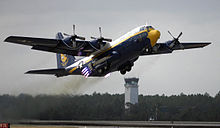
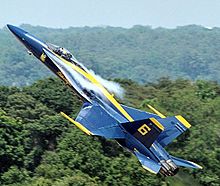
The team flew the McDonnell Douglas F/A-18 Hornet for 34 years from 1986 through 2020. The team currently flies the Boeing F/A-18 Super Hornet.
In August 2018, Boeing was awarded a contract to convert nine single-seat F/A-18E Super Hornets and two F/A-18F two-seaters for Blue Angels use. Modifications to each F/A-18E/F include removal of the weapons and replacement with a tank that contains smoke-oil used in demonstrations and outfitting the control stick with a spring system for more precise aircraft control input. Control sticks are tensioned with 40 pounds (18 kg) of force to allow the pilot minimal room for non-commanded movement of the aircraft. Each modified F/A-18 remains in the fleet and can be returned to combat duty aboard an aircraft carrier within 72 hours.[15] As converted aircraft were delivered, they were used for testing maneuvers starting in mid 2020.[16][17] The team's Super Hornets became operational by the beginning of 2021, their 75th anniversary year.[18]
The show's narrator flies Blue Angels No. 7, a two-seat F/A-18F Hornet, to show sites. The Blues use these jets for backups, and to give demonstration rides to VIP (civilians). Usually, two back seats rides are available at each air show; one goes to a member of the press, and the other to the "Key Influencer".[9] The No. 4 slot pilot often flies the No. 7 aircraft in Friday's "practice" so that pilots from the fleet and future team members can experience the show.
In 2020, the United States Marine Corps Blue Angels purchased a surplus Royal Air Force Lockheed C-130J Super Hercules (RAF registration ZH885, US registration 170000) as the new "Fat Albert", for their logistics, carrying spare parts, equipment, and to carry support personnel between shows.
Team members
[edit]As of the 2020 season[update], there have been 272 demonstration pilots in the Blue Angels since their inception.[19][20]
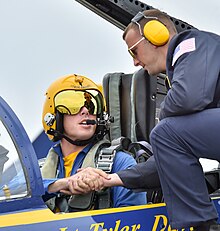
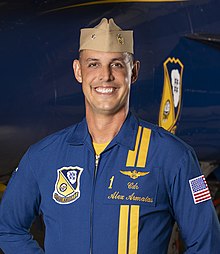
All team members, both officer and enlisted, pilots and staff officers, come from the ranks of regular Navy and United States Marine Corps units. The demonstration pilots and narrator are made up of Navy and USMC Naval Aviators. Pilots serve two to three years,[3] and position assignments are made according to team needs, pilot experience levels, and career considerations for members. Other officers in the squadron include a naval flight officer who serves as the events coordinator, three USMC C-130 pilots, an executive officer, a maintenance officer, a supply officer, a public affairs officer, an administrative officer, and a flight surgeon. Enlisted members range from E-4 to E-9 and perform all maintenance, administrative, and support functions. They serve three to four years in the squadron.[3] After serving with the squadron, members return to fleet assignments.
The officer selection process requires pilots and support officers (flight surgeon, events coordinator, maintenance officer, supply officer, and public affairs officer) wishing to become Blue Angels to apply formally via their chain-of-command, with a personal statement, letters of recommendation, and flight records. Navy and Marine Corps F/A-18 demonstration pilots and naval flight officers are required to have a minimum of 1,250 tactical jet hours and be carrier-qualified. Marine Corps C-130 demonstration pilots are required to have 1,200 flight hours and be an aircraft commander.[22]
Applicants "rush" the team at one or more airshows, paid out of their own finances, and sit in on team briefs, post-show activities, and social events. It is critical that new officers fit the existing culture and team dynamics. The application and evaluation process runs from March through early July, culminating with extensive finalist interviews and team deliberations. Team members vote in secret on the next year's officers. Selections must be unanimous.
The Flight Leader (No. 1) is the commanding officer and always holds the rank of commander, and may be promoted to captain mid-tour if approved by the selection board.
- Current Flight Leader/Commanding Officer
Captain Alexander P. Armatas is a native of Skaneateles, New York. He graduated from the United States Naval Academy in 2002 with a Bachelor of Science in aerospace engineering. Alexander joined the Blue Angels in August 2022. He has accumulated more than 4,100 flight hours and 911 carrier-arrested landings. His decorations include the Meritorious Service Medal, four Strike/Flight Air Medals, five Navy and Marine Corps Commendation Medals, one Navy and Marine Corps Achievement Medal, and various personal, unit and service awards.[23]
- Flight team
Pilots of numbers 2–7 are Navy lieutenant commanders or lieutenants, or Marine Corps majors or captains. The No. 7 pilot narrates for a year, and then typically flies Opposing and then Lead Solo the following two years, respectively. The No. 3 pilot moves to the No. 4 (slot) position for their second year. Blue Angel No. 4 serves as the demonstration safety officer, due largely to the perspective they are afforded from the slot position within the formation, as well as their status as a second-year demonstration pilot. No. 8 serves as Events Coordinator for two years.
Since 2008, six female flight officers have been selected. LCDR. Amanda Lee became the first woman to be named as a F/A-18 demonstration pilot. She is serving as a member of the team as of 2024.[24] CDR. Amy Tomlinson, MAJ. Corrie Mays USMC, LCDR. Katlin Forster, and LCDR. Lilly Montana have served as Events Coordinators. MAJ. Katie Higgins Cook USMC served as a C-130 pilot.
Several minority flight officers have served including CAPT. Donnie Cochran the first African American to command the Blue Angels. Lt. Andre Webb and LCDR. Julius Bratton have served as demonstration pilots.
Flight surgeons serve a two-year term. The flight surgeon provides team medical services, evaluates demonstration maneuvers from the ground, and participates in each post-flight debrief. The first female Blue Angel flight surgeon was Lt. Tamara Schnurr, who was a member of the 2001 team.[25]
Training and weekly routine
[edit]Annual winter training takes place at NAF El Centro, California, where new and returning pilots hone skills learned in the fleet. During winter training, the pilots fly two practice sessions per day, six days a week, to fly the 120 training missions needed to perform the demonstration safely. The separation between the formation of aircraft and their maneuver altitude is gradually reduced over the course of about two months in January and February. The team then returns to their home base in Pensacola, Florida, in March, and continues to practice throughout the show season. A typical week during the season has practices at NAS Pensacola on Tuesday and Wednesday mornings. The team then flies to its show venue for the upcoming weekend on Thursday, conducting "circle and arrival" orientation maneuvers upon arrival. The team flies a "practice" airshow at the show site on Friday. This show is attended by invited guests but is often open to the general public. The main airshows are conducted on Saturdays and Sundays, with the team returning home to NAS Pensacola on Sunday evenings after the show. Monday is an off day for the Blues' demonstration pilots and road crew. Extensive aircraft maintenance is performed on Sunday evening and Monday by maintenance team members.
Pilots maneuver the flight stick with their right hand and operate the throttle with their left. They do not wear G-suits because the air bladders inside repeatedly deflate and inflate, increasing the risk of unintentional movement. To compensate for the lack of G-suits, Blue Angel pilots have developed a method for tensing their muscles to prevent blood from pooling in their lower extremities, possibly rendering them unconscious.[26]
History
[edit]Overview
[edit]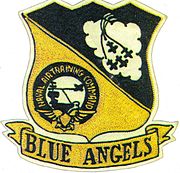
The Blue Angels were originally formed in April 1946 as the Navy Flight Exhibition Team.[27] They changed their name to the Blue Angels after seeing an advertisement for the New York nightclub The Blue Angel, also known as The Blue Angel Supper Club, in the New Yorker Magazine.[28][29] The team was first introduced as the Blue Angels during an air show in July 1946.[30]
The first Blue Angels demonstration aircraft wore navy blue (nearly black) with gold lettering. The current shades of blue and yellow were adopted when the first demonstration aircraft were transitioned from the Grumman F6F-5 Hellcat to the Grumman F8F-1 Bearcat in August 1946; the aircraft wore an all-yellow scheme with blue markings during the 1949 show season.[31]
The original Blue Angels insignia or crest was designed in 1949, by Lt. Commander Raleigh "Dusty" Rhodes, their third Flight Leader and first jet fighter leader. The aircraft silhouettes change as the team changes aircraft.[1]
The Blue Angels transitioned from propeller-driven aircraft to blue and gold jet aircraft (Grumman F9F-2B Panther) in August 1949.[32]
The Blue Angels demonstration teams began wearing leather jackets and special colored flight suits with the Blue Angels insignia, in 1952. In 1953, they began wearing gold colored flight suits for the first show of the season and or to commemorate milestones for the flight demonstration squadron.[33][34][35][36]
The Navy Flight Exhibition Team was reorganized and commissioned the United States Navy Flight Demonstration Squadron on 10 December 1973.[37]
1946–1949
[edit]
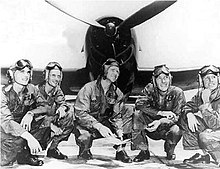
The Blue Angels were established as a Navy flight exhibition team on 24 April 1946 by order of Chief of Naval Operations Admiral Chester Nimitz to generate greater public support of naval aviation. To boost Navy morale, demonstrate naval air power, and maintain public interest in naval aviation, an underlying mission was to help the Navy generate public and political support for a larger allocation of the shrinking defense budget. Rear Admiral Ralph Davison personally selected Lieutenant Commander Roy Marlin "Butch" Voris, a World War II fighter ace, to assemble and train a flight demonstration team, naming him Officer-in-Charge and Flight Leader. Voris selected three fellow instructors to join him (Lt. Maurice "Wick" Wickendoll, Lt. Mel Cassidy, and Lt. Cmdr. Lloyd Barnard, veterans of the War in the Pacific), and they spent countless hours developing the show. The group perfected its initial maneuvers in secret over the Florida Everglades so that, in Voris' words, "if anything happened, just the alligators would know". The first four pilots and those after them, were and are some of the best and most experienced aviators in the Navy.[38]

The team's first demonstration with Grumman F6F-5 Hellcat aircraft took place before Navy officials on 10 May 1946 and was met with enthusiastic approval. The United States Navy's Blue Angels performed their first air show at what is now JaxEx (formerly Craig Municipal Airport, one of 6 airports in the Jacksonville, FL area developed for military training), on June 15, 1946.[39] The exhibition team flew three Gruman F6F Hellcat Fighter planes (a fourth F6F-5 was held in reserve). On 15 June, Voris led the three Hellcats (numbered 1–3), specially modified to reduce weight and painted sea blue with gold leaf trim, through their inaugural 15-minute-long performance.[1] The team employed a North American SNJ Texan, painted and configured to simulate a Japanese Zero, to simulate aerial combat. This aircraft was later painted yellow and dubbed the "Beetle Bomb". This aircraft is said to have been inspired by one of the Spike Jones' Murdering the Classics series of musical satires, set to the tune (in part) of the William Tell Overture as a thoroughbred horse race scene, with "Beetle Bomb" being the "trailing horse" in the lyrics.
The team thrilled spectators with low-flying maneuvers performed in tight formations, and (according to Voris) by "keeping something in front of the crowds at all times. My objective was to beat the Army Air Corps. If we did that, we'd get all the other side issues. I felt that if we weren't the best, it would be my naval career." The Blue Angels' first public demonstration also netted the team its first trophy, which sits on display at the team's current home at NAS Pensacola. During an air show at Omaha, Nebraska on 19–21 July 1946, the Navy Flight Exhibition Team was introduced as the Blue Angels.[40] The name had originated through a suggestion by Right Wing Pilot Lt. Maurice "Wick" Wickendoll, after he had read about the Blue Angel nightclub in The New Yorker magazine. After ten appearances with the Hellcats, the Hellcats were replaced by the lighter, faster, and more powerful F8F-1 Bearcats on 25 August.[40] By the end of the year the team consisted of four Bearcats numbered 1–4 on the tail sections.
In May 1947, flight leader Lt. Cmdr. Bob Clarke replaced Butch Voris as the leader of the team. The team with an additional fifth pilot, relocated to Naval Air Station (NAS) Corpus Christi, Texas. On 7 June at Birmingham, Alabama, four F8F-1 Bearcats (numbered 1–4) flew in diamond formation for the first time which is now considered the Blue Angels' trademark. A fifth Bearcat was also added that year. A SNJ was used as a Japanese Zero for dogfights with the Bearcats in air shows.
In January 1948, Lt. Cmdr. Raleigh "Dusty" Rhodes took command of the Blue Angels team which was flying four Bearcats and a yellow painted SNJ with USN markings dubbed "Beetle Bomb"; the SNJ represented a Japanese Zero for the air show dogfights with the Bearcats. The name "Blue Angels" also was painted on the Bearcats.[41]
In 1949, the team acquired a Douglas R4D Skytrain for logistics to and from show sites. The team's SNJ was also replaced by another Bearcat, painted yellow for the air combat routine, inheriting the "Beetle Bomb" nickname. In May, the team went to the west coast on temporary duty so the pilots and the rest of the team could become familiar with jet aircraft.[38] On 13 July, the team acquired, and began flying the straight-wing Grumman F9F-2B Panther between demonstration shows.[42] On 20 August, the team debuted the panther jets under Team Leader Lt. Commander Raleigh "Dusty" Rhodes[40] during an air show at Beaumont, Texas and added a sixth pilot.[43][44] The F8F-1 "Beetle Bomb" was relegated to solo aerobatics before the main show, until it crashed on takeoff at a training show in Pensacola on 24 April 1950, killing "Blues" pilot Lt. Robert Longworth. Team headquarters shifted from NAS Corpus Christi, Texas, to NAAS Whiting Field, Florida, on 10 September 1949, announced 14 July 1949.[45]
1950–1959
[edit]
The Blue Angels pilots continued to perform nationwide in 1950. On 25 June, the Korean War started, and all Blue Angels pilots[46] volunteered for combat duty. The squadron (due to a shortage of pilots, and no available planes) and its members were ordered to "combat-ready status" after an exhibition at Naval Air Station, Dallas, Texas on 30 July.[38] The Blue Angels were disbanded,[40] and its pilots were reassigned to a carrier. Once aboard the aircraft carrier USS Princeton on 9 November, the group formed the core of Fighter Squadron 191 (VF-19), "Satan's Kittens", under the command of World War II fighter ace and 1950 Blue Angels Commander/Flight Leader, Lt. Commander John Magda; he was killed in action on 8 March 1951.[47]
On 25 October 1951, the Blues were ordered to re-activate as a flight demonstration team, and reported to NAS Corpus Christi, Texas. Lt. Cdr. Voris was again tasked with assembling the team (he was the first of only two commanding officers to lead them twice). In May 1952, the Blue Angels began performing again with F9F-5 Panthers[48] at an airshow in Memphis, Tennessee.[38] In 1953, the team traded its Sky Train for a Curtiss R5C Commando. In August, "Blues" leader LCDR Ray Hawkins became the first naval aviator to survive an ejection at supersonic speeds when a new F9F-6 he was piloting became uncontrollable on a cross-country flight.[49][50][51] After summer, the team began demonstrating with F9F-6 Cougar.
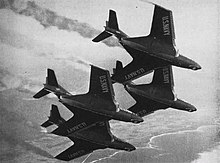
In 1954, the first Marine Corps pilot, Captain Chuck Hiett, joined the Navy flight demonstration team.[52] The Blue Angels also received special colored flight suits.[40] In May, the Blue Angels performed at Bolling Air Force Base in Washington, D.C., with the Air Force Thunderbirds (activated 25 May 1953).[53] The Blue Angels began relocating to their current home at Naval Air Station (NAS) Pensacola, Florida that winter,[54] and it was here they progressed to the swept-wing Grumman F9F-8 Cougar. In December, the team left its home base for its first winter training facility at Naval Air Facility El Centro, California[55]
In September 1956, the team added a sixth aircraft to the flight demonstration in the Opposing Solo position,[56] and gave its first performance outside the United States at the International Air Exposition in Toronto, Ontario, Canada. It also upgraded its logistics aircraft to the Douglas R5D Skymaster.[57]
In 1957, the Blue Angels transitioned from the F9F-8 Cougar to the supersonic Grumman F11F-1 Tiger.[58] The first demonstration was flying the short-nosed version on 23 March, at Barin Field, Pensacola, and then the long-nosed versions. The demonstration team (with added Angel 6) wore gold flight suits during the first air show that season.
In 1958, the first Six-Plane Delta Maneuvers were added that season.[citation needed]
1960–1969
[edit]
In July 1964, the Blue Angels participated in the Aeronaves de Mexico Anniversary Air Show over Mexico City, Mexico, before an estimated crowd of 1.5 million people.
In 1965, the Blue Angels conducted a Caribbean island tour, flying at five sites. Later that year, they embarked on a European tour to a dozen sites, including the Paris Air Show, where they were the only team to receive a standing ovation.
In 1967, the Blues toured Europe again, at six sites.
In 1968, the C-54 Skymaster transport aircraft was replaced with a Lockheed VC-121J Constellation. The Blues transitioned to the two-seat McDonnell Douglas F-4J Phantom II in 1969, nearly always keeping the back seat empty for flight demonstrations. The Phantom was the only plane to be flown by both the "Blues" and the United States Air Force Thunderbirds (the "Birds"). That year they also upgraded to the Lockheed C-121 Super Constellation for logistics.

1970–1979
[edit]

In 1970, the Blues received their first U.S. Marine Corps Lockheed KC-130F Hercules, manned by an all-Marine crew. That year, they went on their first South American tour.[citation needed]
In 1971, the team which wore the gold flight suits for the first show,[59] conducted its first Far East Tour, performing at a dozen locations in Korea, Japan, Taiwan, Guam, and the Philippines.
In 1972, the Blue Angels were awarded the Navy's Meritorious Unit Commendation for the two-year period from 1 March 1970 to 31 December 1971. Another European tour followed in 1973, including air shows in Iran, England, France, Spain, Turkey, Greece, and Italy.
On 10 December 1973, the Navy Flight Exhibition Team was reorganized and commissioned the United States Navy Flight Demonstration Squadron.[60][61] The Blues mission was more on Navy recruiting.
In 1974, the Blue Angels transitioned to the new Douglas A-4F Skyhawk II. Navy Commander Anthony Less became the squadron's first "commanding officer" and "flight leader". A permanent flight surgeon position and administration officer was added to the team.[60][61] The squadron's mission was redefined by Less to further improve the recruiting effort.
Beginning in 1975, "Bert" was used for Jet Assisted Take Off (JATO) and short aerial demonstrations just prior to the main event at selected venues, but the JATO demonstration ended in 2009 due to dwindling supplies of rockets.[62] "Fat Albert Airlines" flies with an all-Marine crew of three officers and five enlisted personnel.
1980–1989
[edit]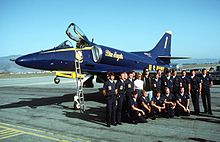
In 1986, LCDR Donnie Cochran, joined the Blue Angels as the first African-American Naval Aviator to be selected.[63][64] He served for two more years with the squadron flying the left wing-man position in the No. 3 A-4F fighter, and returned to command the Blue Angels in 1995 and 1996.[65]
On 8 November 1986, the Blue Angels completed their 40th anniversary year during ceremonies unveiling what would be their aircraft through their 75th anniversary year, the McDonnell Douglas F/A-18 Hornet. The power and aerodynamics of the Hornet allows them to perform a slow, high angle of attack "tail sitting" maneuver, and to fly a "dirty" (landing gear down) formation loop.[66][67]
1990–1999
[edit]Today is a very special and memorable day in your military career that will remain with you throughout your lifetime. You have survived the ultimate test of your peers and have proven to be completely deserving to wear the crest of the U.S. Navy Blue Angels. The prestige of wearing the Blue Angels uniform carries with it an extraordinary honor – one that reflects not only on you as an individual, but on your teammates and the entire squadron. To the crowds at the air shows and to the public at hospitals and schools nationwide, you are a symbol of the Navy and Marine Corps' finest. You bring pride, hope and a promise for tomorrow's Navy and Marine Corps in the smiles and handshakes of today's youth. Remember today as the day you became a Blue Angel; look around at your teammates and commit this special bond to memory. "Once a Blue Angel, always a Blue Angel," rings true for all those who wear the crest of the U.S. Navy Blue Angels. Welcome to the team.
The Blue Angels Creed, written by JO1 Cathy Konn 1991–1993[68]
In 1992, the Blue Angels deployed for a month-long European tour, their first in 19 years, conducting shows in Sweden, Finland, Russia (first foreign flight demonstration team to perform there), Romania, Bulgaria, Italy, the United Kingdom, and Spain.
In 1998, CDR Patrick Driscoll made the first "Blue Jet" landing on a "haze gray and underway" aircraft carrier, USS Harry S. Truman (CVN-75).
On 8 October 1999, the Blue Angels lost two pilots. LCDR Kieron O'Connor and LT Kevin Colling were returning from a practice flight before an air show when their F/A-18B crashed in a wooded area of south Georgia.[69]
2000–2009
[edit]In 2000, the Navy was conducting investigations in regard and connected to the loss of two Blue Angels pilots in October 1999. The pilots of the F/A-18 Hornet were not required to wear and do not wear g-suits.[70]
In 2006, the Blue Angels marked their 60th year of performing.[71] On 30 October 2008, a spokesman for the team announced that the team would complete its last three performances of the year with five jets instead of six. The change was because one pilot and another officer in the organization had been removed from duty for engaging in an "inappropriate relationship". The Navy said one of the individuals was a man and the other a woman, one a Marine and the other from the Navy, and that Rear Admiral Mark Guadagnini, chief of Naval air training, was reviewing the situation.[72] At the next performance at Lackland Air Force Base following the announcement the No. 4 or slot pilot, was absent from the formation. A spokesman for the team would not confirm the identity of the pilot removed from the team.[73] On 6 November 2008, both officers were found guilty at an admiral's mast on unspecified charges but the resulting punishment was not disclosed.[74]
On 21 April 2007, pilot Kevin "Kojak" Davis was killed and eight people on the ground were injured when Davis lost control of the No. 6 jet and crashed during an air show at the Marine Corps Air Station Beaufort in Beaufort, South Carolina.[75]
The Fat Albert performed its final JATO demonstration at the 2009 Pensacola Homecoming show, expending their eight remaining JATO bottles. This demonstration not only was the last JATO performance of the squadron, but also the final JATO use of the U.S. Marine Corps.[76]
In 2009, the Blue Angels were inducted into the International Air & Space Hall of Fame at the San Diego Air & Space Museum.[77]
2010–2019
[edit]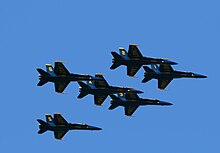
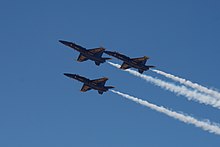
On 22 May 2011, the Blue Angels were performing at the Lynchburg Regional Airshow in Lynchburg, Virginia, when the Diamond formation flew the Barrel Roll Break maneuver at an altitude lower than the required minimum.[78] The maneuver was aborted, the remainder of the demonstration canceled and all aircraft landed safely. The next day, the Blue Angels announced that they were initiating a safety stand-down, canceling their upcoming Naval Academy Airshow and returning to their home base in Pensacola, Florida, for additional training and airshow practice.[79] On 26 May, the Blue Angels announced they would not be flying their traditional fly-over of the Naval Academy Graduation Ceremony and that they were canceling their 28–29 May 2011 performances at the Millville Wings and Wheels Airshow in Millville, New Jersey.
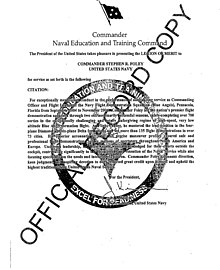
On 27 May 2011, the Blue Angels announced that Commander Dave Koss, the squadron's commanding officer, would be stepping down. He was replaced by Captain Greg McWherter, the team's previous commanding officer.[80] The squadron canceled performances at the Rockford, Illinois Airfest 4–5 June and the Evansville, Indiana Freedom Festival Air Show 11–12 June to allow additional practice and demonstration training under McWherter's leadership.[80]
On 29 July 2011, a new Blue Angels Mustang GT was auctioned off for $400,000 at the Experimental Aircraft Association AirVenture Oshkosh (Oshkosh Air Show) annual summer gathering of aviation enthusiasts from 25 to 31 July in Oshkosh, Wisconsin which had an attendance of 541,000 persons and 2,522 show planes.[81][82]
Between 2 and 4 September 2011 on Labor Day weekend, the Blue Angels flew for the first time with a fifty-fifty blend of conventional JP-5 jet fuel and a camelina-based biofuel at Naval Air Station Patuxent River, Maryland.[83] McWherter flew an F/A-18 test flight on 17 August and stated there were no noticeable differences in performance from inside the cockpit.[84][85]
On 1 March 2013, the U.S. Navy announced that it was cancelling remaining 2013 performances after 1 April 2013 due to sequestration budget constraints.[86][87] In October 2013, Secretary of Defense Chuck Hagel, stating that "community and public outreach is a crucial Departmental activity", announced that the Blue Angels (along with the U.S. Air Force's Thunderbirds) would resume appearing at air shows starting in 2014, although the number of flyovers will continue to be severely reduced.[88]
On 15 March 2014, the demonstration pilots numbered 1–7 wore gold flight suits to celebrate the team's "return to the skies" during their first air show of the season;[89] there were only three air shows in 2013.
In July 2014, Marine Corps C-130 pilot Capt. Katie Higgins, 27, became the first female pilot to join the Blue Angels, flying the support aircraft Fat Albert for the 2015 and 2016 show seasons.[90]
In July 2015, Cmdr. Bob Flynn became the Blue Angels' first executive officer.[91]
On 2 June 2016, Capt. Jeff Kuss, an Opposing Solo, died just after takeoff while performing the Split-S maneuver in his Hornet during a practice run for The Great Tennessee Air Show in Smyrna, Tennessee. The Navy's investigation found that Capt. Kuss had performed the maneuver too low while failing to retard the throttle out of afterburner, causing him to fall too fast and recover too low above the ground. Capt. Kuss ejected, but his parachute was immediately engulfed in flames, causing him to fall to his death. Kuss' body was recovered just yards away from the crash site. The cause of death was blunt force trauma to the head. The investigation also cited weather and pilot fatigue as additional causes of the crash. In a strange twist, Captain Kuss' fatal crash happened hours after the Blue Angels' fellow pilots in the United States Air Force Thunderbirds suffered a crash of their own, following the United States Air Force Academy graduation ceremony earlier that day. Capt. Jeff Kuss was replaced by Cmdr. Frank Weisser to finish out the 2016 and 2017 seasons.[citation needed]
In July 2016, Boeing was awarded a $12 million contract to begin an engineering proposal for converting the Boeing F/A-18E/F Super Hornet for Blue Angels use, with the proposal to be completed by September 2017.[92]
The Fat Albert (BUNO 164763) was retired from service in May 2019 with 30,000 flight hours. The Blue Angels replaced it with a C-130J Super Hercules acquired from the Royal Air Force (BUNO 170000).[93]
2020–present
[edit]
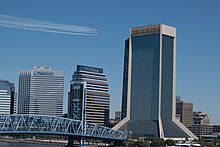
In response to the COVID-19 pandemic in the United States, the Blue Angels flew over multiple US cities as a tribute to healthcare and front line workers.[94]
The Blues officially transitioned to Boeing F/A-18E/F Super Hornets on 4 November 2020.[95][96]
In July 2022, Lt. Amanda Lee was announced as the first woman to serve as a demonstration pilot in the Blue Angels.[24][97]
Aircraft timeline
[edit]
The "Blues" have flown ten different demonstration aircraft and six support aircraft models:[57][98]
- Demonstration aircraft
- Grumman F6F-5 Hellcat: June – August 1946
- Grumman F8F-1 Bearcat: August 1946 – 1949
- Grumman F9F-2 Panther: 1949 – June 1950 (first jet); F9F-5 Panther: 1951 – Winter 1954/55
- Grumman F9F-8 Cougar: Winter 1954/55 – mid-season 1957 (swept-wing)
- Grumman F11F-1 (F-11) Tiger: mid-season 1957 – 1968 (first supersonic jet)
- McDonnell Douglas F-4J Phantom II: 1969 – December 1974
- Douglas A-4F Skyhawk: December 1974 – November 1986
- McDonnell Douglas F/A-18 Hornet (F/A-18B as #7): November 1986 – 2010[99]
- Boeing F/A-18A/C (B/D as #7) Hornet: 2010-2020[100][101]
- Boeing F/A-18E Super Hornet (F/A-18F as #7): 2020–[102]
- Support aircraft
- JRB Expeditor (Beech 18): 1949–?
- Douglas R4D-6 Skytrain: 1949–1955
- Curtiss R5C Commando: 1953
- Douglas R5D Skymaster: 1956–1968
- Lockheed C-121 Super Constellation: 1969–1973
- Lockheed C-130 Hercules "Fat Albert": 1970–2019 (JATO usage was stopped in 2009)[103]
- Lockheed Martin C-130J Super Hercules "Fat Albert": 2020–present
- Miscellaneous aircraft
- North American SNJ Texan "Beetle Bomb" (used to simulate a Japanese A6M Zero aircraft in demonstrations during the late 1940s)
- Lockheed T-33 Shooting Star (Used during the 1950s as a VIP transport aircraft for the team)
- Vought F7U Cutlass (two of the unusual F7Us were received in late 1952 and flown as a side demonstration during the 1953 season but they were not a part of their regular formations which at the time used the F9F Panther. Pilots and ground crew found it unsatisfactory and a plan to use it as the team's primary aircraft was canceled).
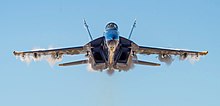
An approaching Boeing F/A-18E/F Super Hornet
Commanding officers
[edit]Notable Commanding Officers include;
- Roy Marlin Voris – 1946, 1952
- John J. Magda – 1950, Killed in Action March 1951, Korean War[104]
- Arthur Ray Hawkins – 1952 to 1953[105]
- Richard Cormier – 1954 to 1956[106]
- Edward B. Holley – 1957 to 1958
- Zebulon V. Knott – 1959 to 1961[107]
- Kenneth R. Wallace – 1962 to 1963[108]
- Robert F. Aumack – 1964 to 1966[109]
- William V. Wheat – 1967 to 1969[110]
- Harley H. Hall – 1970 to 1971
- Don Bently – 1972
- Marvin F. "Skip" Umstead – 1973[111]
- Anthony A. Less – Oct 1973 to Jan 1976
- Keith S. Jones – 1976 to 1978[112]
- William E. Newman – 1978 to 1979[113]
- Hugh D. Wisely – Dec 1979 to 1982[114]
- David Carroll – 1982 to 1983
- Larry Pearson – 1983 to 1985[115]
- Gilman E. Rud – Nov 1985 to Nov 1988[116]
- Gregory Wooldridge – 1990 to 1992, 1996[117]
- Robert E. Stumpf – 1993 to 1994[118]
- Donnie Cochran – Nov 1994 to May 1996
- George B. Dom – Nov 1996 to Oct 1998[119]
- Patrick Driscoll – Oct 1998 to 2000[120]
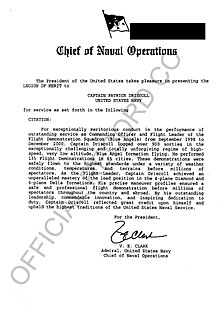
- Robert Field – 2000 to Sept 2002
- Russell J. Bartlett – Sept 2002 to Sept 2004[121]
- Stephen R. Foley – Sept 2004 to Nov 2006[122]
- Kevin Mannix – Nov 2006 to 2008[123]
- Gregory McWherter 2008 to 2010, 2011[124]
- David Koss – Fall 2010 to spring of 2011
- Gregory McWherter – 2011 to 2012
- Thomas Frosch – 2012 to 2015[125]
- Ryan Bernacchi – 2015 to 2017[126]
- Eric D. Doyle – 2017 to 2019
- Brian C. Kesselring – 2019 to 2022
- Alexander P. Armatas – 2022 to present
Notable members
[edit]Below are some of the more notable members of the Blue Angels squadron:
- Capt Roy "Butch" Voris, World War II fighter ace and first Flight Leader
- Charles "Chuck" Brady Jr., Astronaut and physician
- Donnie Cochran, First African-American Blue Angels aviator and commander
- Edward L. Feightner, World War II fighter ace and Lead Solo
- Arthur Ray Hawkins, World War II flying ace
- Bob Hoover, World War II fighter pilot and flight instructor, honorary Blue Angel member
- Anthony A. Less, First Commanding Officer of Blue Angels squadron, numerous other commands including Naval Air Forces Atlantic Fleet
- Robert L. Rasmussen, aviation artist
- Raleigh Rhodes, World War II and Korean War fighter pilot and third Flight Leader of the Blue Angels[127]
- Patrick M. Walsh, Left Wingman and Slot Pilot who later commanded the U.S. Pacific Fleet and became Vice Chief of Naval Operations and a White House Fellow
- Katie Higgins Cook, First female Blue Angels pilot
- Amanda Lee, First female Blue Angels demonstration pilot
Team accidents and deaths
[edit]A total of 20 Blue Angels pilots and one crew member have died while assigned to the flight team.[128][129] Four other pilots died in combat action after their service with the Blue Angels.[128]
Deaths
[edit]- Lt. Ross "Robby" Robinson – 29 September 1946: killed during a performance when a wingtip broke off his F8F-1 Bearcat, sending him into an unrecoverable spin.
- Lt. Bud Wood – 7 July 1952: killed when his F9F-5 Panther collided with another Panther jet during a demonstration in Corpus Christi, Texas.[130] The team resumed performances two weeks later.
- Cmdr. Robert Nicholls Glasgow – 14 October 1958: died during an orientation flight just days after reporting for duty as the new Blue Angels leader.[131]
- Lt. Anton M. Campanella (#3 Left Wing) – 14 June 1960: killed flying a Grumman F-11A Tiger that crashed into the water near Fort Morgan, Alabama during a test flight.[130]
- Lt. George L. Neale – 15 March 1964: killed during an attempted emergency landing at Apalach Airport near Apalachicola, Florida. Lt. Neale's F-11A Tiger had experienced mechanical difficulties during a flight from West Palm Beach, to Naval Air Station Pensacola, causing him to attempt the emergency landing. Failing to reach the airport, he ejected from the aircraft on final approach, but his parachute did not have sufficient time to fully deploy.[132]
- Lt. Cmdr. Dick Oliver – 2 September 1966: crashed his F-11A Tiger and was killed at the Canadian International Air Show in Toronto.
- Lt Frank Gallagher – 1 February 1967: killed when his F-11A Tiger stalled during a practice Half Cuban Eight maneuver and spun into the ground.
- Capt. Ronald Thompson – 18 February 1967: killed when his F-11A Tiger struck the ground during a practice formation loop.
- Lt. Bill Worley (Opposing Solo) – 14 January 1968: killed when his Tiger crashed during a practice double Immelmann.
- Lt. Larry Watters – 14 February 1972: killed when his F-4J Phantom II struck the ground, upright, while practicing inverted flight, during winter training at NAF El Centro.
- Lt. Cmdr. Skip Umstead (Team Leader), Capt. Mike Murphy, and ADJ1 Ron Thomas (Crew Chief) – 26 July 1973: all three were killed in a mid-air collision between two Phantoms over Lakehurst, New Jersey, during an arrival practice. The rest of the season was cancelled after this incident.
- Lt. Nile Kraft (Opposing Solo) – 22 February 1977: killed when his Skyhawk struck the ground during practice.
- Lt. Michael Curtin – 8 November 1978: one of the solo Skyhawks struck the ground after low roll during arrival maneuvers at Naval Air Station Miramar, and Curtin was killed.
- Lt. Cmdr. Stu Powrie (Lead Solo) – 22 February 1982: killed when his Skyhawk struck the ground during winter training at Naval Air Facility El Centro, California, just after a dirty loop.
- Lt. Cmdr. Mike Gershon (Opposing Solo #6) – 13 July 1985: his Skyhawk collided with Lt. Andy Caputi (Lead Solo #5) during a show at Niagara Falls, Gershon was killed and Caputi ejected and parachuted to safety.[133]
- Lt. Cmdr. Kieron O'Connor and Lt. Kevin Colling – 28 October 1999: flying in the back seat and front seat of a Hornet, both were killed after striking the ground during circle and arrival maneuvers in Valdosta, Georgia.[134]
- Lt. Cmdr. Kevin J. Davis – 21 April 2007: crashed his Hornet near the end of the Marine Corps Air Station Beaufort airshow in Beaufort, South Carolina, and was killed.[135]
- Capt. Jeff Kuss (Opposing Solo, #6) – 2 June 2016: died just after takeoff while performing the Split-S maneuver in his F/A-18 Hornet during a practice run for The Great Tennessee Air Show in Smyrna, Tennessee.
Other incidents
[edit]- Lt. John R. Dewenter – 2 August 1958: landed wheels up at Buffalo Niagara International Airport after experiencing engine troubles during a show in Clarence, New York. The Grumman F-11 Tiger landed on Runway 23, but exited airport property, coming to rest in the intersection of Genesee Street and Dick Road, nearly hitting a filling station. Lt. Dewenter was uninjured, but the plane was a total loss.
- Lt. Ernie Christensen – 30 August 1970: belly-landed his F-4J Phantom at The Eastern Iowa Airport in Cedar Rapids, Iowa, after he inadvertently left the landing gear in the up position.[136] He ejected safely, while the aircraft slid off the runway.
- Cmdr. Harley Hall – 4 June 1971: safely ejected after his F-4J Phantom jet caught fire during practice over NAS Quonset Point in North Kingstown, Rhode Island, and crashed in Narragansett Bay.[137]
- Capt. John Fogg, Lt. Marlin Wiita, and Lt. Cmdr. Don Bently – 8 March 1973: all three survived a multi-aircraft mid-air collision during practice over Superstition Mountain, near El Centro, California.
- Lt. Jim Ross (Lead Solo) – April 1980: unhurt when his Skyhawk suffered a fuel line fire during a show at Roosevelt Roads Naval Station, Puerto Rico. Lt. Ross stayed with the plane and landed, leaving the end of the runway and rolling into the woods after a total hydraulic failure upon landing.
- Lt. Dave Anderson (Lead Solo) – 12 February 1987: ejected from his Hornet after a dual engine flame-out during practice near El Centro, California.
- Marine Corps Maj. Charles Moseley and Cmdr. Pat Moneymaker – 23 January 1990: their Blue Angel Hornets suffered a mid-air collision during a practice at El Centro. Moseley ejected safely and Moneymaker was able to land his airplane, which then required a complete right wing replacement.[138]
- Lt. Ted Steelman – 1 December 2004: ejected from his F/A-18 approximately one mile off Perdido Key after his aircraft struck the water, suffering catastrophic engine and structural damage. He suffered minor injuries.[139]
Combat casualties
[edit]Four former Blue Angels pilots have been killed in action or died after being captured, all having been downed by anti-aircraft fire.[140]
Korean War
[edit]- Commander John Magda – 8 March 1951: Blue Angels (1949, 1950; Commander/Flight Leader 1950): Magda was killed after his F9F-2B Panther was hit by anti aircraft fire while leading a low-level strike mission against North Korean and Chinese communist positions at Tanchon which earned him the Navy Cross during the Korean War.[141] He also was a fighter ace in World War II.
Vietnam War
[edit]- Commander Herbert P. Hunter – 19 July 1967: Blue Angels (1957–1959; Lead Solo pilot): Hunter was hit by anti-aircraft fire in North Vietnam and crashed in his F-8E Crusader during the Vietnam war.[142][143] He was awarded the Distinguished Flying Cross posthumously for actions on 16 July 1967. He also was a Korean War veteran.
- Captain Clarence O. Tolbert – 6 November 1972: Blue Angels (1968): Tolbert was flying a Corsair II (A-7B) during a mission in North Vietnam and was hit by anti-aircraft fire, crashed, and died during his second tour in the Vietnam war. He was awarded the Silver Star and Distinguished Flying Cross for his service.[144]
- Captain Harley H. Hall – 27 January 1973: Blue Angels (1970–1971; Commander/Team Leader 1971): Hall and his co-pilot were shot down by anti-aircraft fire in South Vietnam flying their F-4J Phantom II on the last day of the Vietnam War, and they both were officially listed as prisoners of war. In 1980, Hall was presumed to have died while captured.[145][146][147] His remains were identified on 6 September 1994.[148]
In the media
[edit]
- The Blue Angels was a dramatic television series, starring Dennis Cross and Don Gordon, inspired by the team's exploits and filmed with the cooperation of the Navy. It aired in syndication from 26 September 1960 to 3 July 1961.[149]
- Threshold: The Blue Angels Experience is a 1975 documentary film, written by Dune author Frank Herbert, featuring the team in practice and performance during their F-4J Phantom era; many of the aerial photography techniques pioneered in Threshold were later used in the film Top Gun.[150]
- To Fly!, a short IMAX film featured at the Smithsonian Air and Space Museum since its 1976 opening features footage from a camera on a Blue Angels A4 Skyhawk tail as the pilot performs in a show.[151]
- In 1981, the Blue Angels along with the USAF Thunderbirds were featured on a Laserdisc released in Japan called Blue Angels/Thunderbirds.[152]
- The Blue Angels were featured in the 1986 music video for "Dreams"[153] by rock band Van Halen, flying the A-4 Skyhawk.
- In 1987, the Blue Angels were featured in Rolling in the Sky: F/A-18 Blue Angels.[154]
- In 1996, the Blue Angels appeared in the IMAX short film The Magic of Flight, narrated by Tom Selleck.[155]
- In 2005, the Discovery Channel aired a documentary miniseries, Blue Angels: A Year in the Life, focusing on the intricate day-to-day details of that year's training and performance schedule.[156][157]
- In 2009, MythBusters enlisted the aid of Blue Angels to help test the myth that a sonic boom could shatter glass.[158]
- In 2024, the Blue Angels appeared in the IMAX feature film The Blue Angels, depicting the team's 2022 training and show seasons.[159]
See also
[edit]- List of United States Navy aircraft squadrons
- United States Air Force Thunderbirds
- United States Marine Corps Aviation
References
[edit]- ^ a b c "History of the Blue Angels". Blue Angels official site.
- ^ "Show Information And Schedules, 2019 Show Schedule". United States Navy. Retrieved 10 March 2019.
- ^ Atkeison, Charles (2018). "Navy's Blue Angels Announce New Pilots, Officers for 2019". AVGEEKERY.COM. Retrieved 15 March 2019.
- ^ "Blue Angels fly into age of budget woes". USA Today. 23 November 2011. Archived from the original on 29 March 2014. Retrieved 23 November 2011.
- ^ "Blue Angels FAQ". Archived from the original on 4 April 2012.
- ^ "Blue Angels: Frequently Asked Questions". United States Navy. Archived from the original on 23 November 2016. Retrieved 22 April 2020.
- ^ "U.S. Navy Blue Angels". US Navy.
- ^ Bindman, Ariana (6 October 2022). "No, the world isn't ending, it's just the Blue Angels preparing for San Francisco Fleet Week". SF GATE. Retrieved 1 September 2024.
- ^ a b "Opinion | The Problem With the Blue Angels | Common Dreams". www.commondreams.org. Retrieved 1 September 2024.
- ^ Maury (8 July 2022). "Navy Blue Angels' Buzzing of Buildings Is Up in the Air a Year After a Flyby Injured a Dozen". Association of Naval Aviation in Virginia Beach, Virginia - Hampton Roads Squadron. Retrieved 1 September 2024.
- ^ CHS Staff (30 July 2024). "Duck, Capitol Hill: The Blue Angels are back above Seattle — Here's the 2024 schedule". Capitol Hill Seattle Blog.
- ^ Lamothe, Dan (22 April 2020). "Pentagon plans to dispatch Blue Angels and Thunderbirds in coronavirus tribute". The Washington Post. Retrieved 1 September 2024.
- ^ Garrett Reim (15 August 2018). "Boeing to convert F/A-18 E/Fs into Blue Angels". flightglobal.com. Archived from the original on 16 August 2018. Retrieved 16 August 2018.
- ^ "U.S. Navy Blue Angels". Facebook.com. Archived from the original on 25 February 2022. Retrieved 30 January 2021.[self-published source?]
- ^ "U.S. Navy Blue Angels". Facebook. Archived from the original on 25 February 2022. Retrieved 30 January 2021. [self-published source?]
- ^ Corillo, Todd (10 November 2020). "Blue Angels transition to Super Hornets ahead of 75th anniversary". WTKR News. Retrieved 4 January 2021.
- ^ U.S. Navy Blue Angels |Frequently Asked Questions, #9 Archived 23 November 2016 at the Wayback Machine, last updated 17 March 2019.
- ^ "List of every Blue Angels team". Archived from the original on 8 December 2019. Retrieved 8 December 2019.
- ^ "Officers". Blue Angels. Archived from the original on 23 November 2016.
- ^ "Blue Angels Seek Officer Applicants" (PDF). Gosport NAS Pensacola Base Newspaper. 2 March 2012. p. 2. Archived (PDF) from the original on 9 October 2022.[permanent dead link]
- ^ "Team Officers". US Navy. Retrieved 1 December 2022.
- ^ a b "Blue Angels name first woman to serve as demonstration pilot". USA Today. 18 July 2022.
- ^ "Blue Angels Alumni 2001". Blue Angels Association. Archived from the original on 4 October 2012. Retrieved 3 March 2012.
- ^ "Blue Angels Frequently Asked Questions". United States Navy. Archived from the original on 4 April 2012. Retrieved 3 March 2012.
- ^ "Flight Teams, 1946". Blue Angels Association. Archived from the original on 23 March 2019. Retrieved 17 March 2019.
- ^ "Butch Voris and the Blue Angels", US Navy Blue Angels website
- ^ Tommor, Samantha (21 March 2012). "Blue Angels fly over St. George, thunder over Dixie". Dixie Sun News. Archived from the original on 30 October 2020. Retrieved 27 September 2020.
- ^ "Blue Angels History". Aerobatic Teams. Retrieved 12 March 2019.
- ^ Campbell, War Paint, p. 171.
- ^ "Flight Teams, 1949". Blue Angels Association. Archived from the original on 23 March 2019. Retrieved 17 March 2019.
- ^ "Flight Teams, yearly photos". Blue Angels Association. Archived from the original on 23 March 2019. Retrieved 16 March 2019.
- ^ "Wearing Gold: The Blue Angels Return To The Skies. March 16, 2014". NorthEscabia.com. Retrieved 11 March 2019.
- ^ "US Navy Blue Angels 1st Air Show in 2014 on March 15 at El Centro California". 13 April 2014. Archived from the original on 3 November 2021. Retrieved 12 March 2019 – via YouTube.
- ^ "Harley Hall: Vietnam POW (wearing BA gold flight suit-1971)". OPB TV/Radio. Archived from the original on 30 April 2020. Retrieved 16 March 2019.
- ^ "History of the Blue Angels/Significant Events in Blue Angels History, 1970s". Blue Angels. Retrieved 14 March 2019.
- ^ a b c d "Blue Angels Article, August 1955". Naval Aviation News. Retrieved 4 March 2019.
- ^ "Jacksonville International Airport".
- ^ a b c d e "Blue Angels History". Aerobatic Teams. Retrieved 6 March 2019.
- ^ Kula, Ken (24 March 2019). "Seventy Years Strong: The U.S. Navy's Blue Angels". PhotoRecon. Retrieved 24 March 2016.
- ^ "Blue Angels". Military in Pensacola. Retrieved 5 March 2019.
- ^ "Raleigh Dusty Rhodes". Getty Images. Archived from the original on 5 August 2019. Retrieved 18 March 2019.
- ^ "Flight Teams, 1949". Blue Angels Association. Archived from the original on 23 March 2019. Retrieved 17 March 2019.
- ^ "'Blue Angels' To Pensacola – Navy Flight Exhibition Team Is Transferred". Playground News. 14 July 1949. Volume 4, Number 24, page 2.
- ^ "Flight Teams, 1950 (Flight Leader John Magda, second from right)". Blue Angels Association. Archived from the original on 23 March 2019. Retrieved 17 March 2019.
- ^ "A Blue Angel's First Combat Flight at Midway". Naval History and Heritage Command. 3 June 2015. Retrieved 23 July 2022.
- ^ "Flight Teams, 1952". Blue Angels Association. Archived from the original on 23 March 2019. Retrieved 17 March 2019.
- ^ "2005". ejection-history.org.uk. Archived from the original on 27 May 2006. Retrieved 16 November 2014.
- ^ Wilcox, R.K. (2004). First Blue: The Story of World War II Ace Butch Voris and the Creation of the Blue Angels. St. Martin's Press. pp. 2–237. ISBN 978-0-3123-2249-6. Retrieved 16 November 2014.
- ^ "Blue Angel Ejects at High Speed". Naval Aviation News. October 1952 – via Blue Angels Association.
- ^ "Flight Teams, 1954, 1955". Blue Angels Association. Archived from the original on 23 March 2019. Retrieved 17 March 2019.
- ^ Dorr, Robert F. (11 October 2011). "The Blue Angels: A 65 Year History". DefenseMediaNetwork. Retrieved 8 March 2019.
- ^ Gall, Sandy. "How well do you know the Blue Angels?". CHIPS: the Department of the Navy's Information Technology Magazine. Archived from the original on 21 December 2016. Retrieved 14 December 2016.
- ^ "History of the Blue Angels, 1950s". Blue Angels. Retrieved 15 March 2019.
- ^ "Flight Teams, 1956". Blue Angels Association. Archived from the original on 23 March 2019. Retrieved 17 March 2019.
- ^ a b "Blue Angels: Historical Aircraft – 60+ Years of Aviation Excellence". Archived from the original on 19 April 2012. Retrieved 3 March 2012.
- ^ "Flight Teams, 1957". Blue Angels Association. Archived from the original on 23 March 2019. Retrieved 17 March 2019.
- ^ "Flight Teams, 1971". Blue Angels Association. Archived from the original on 23 March 2019. Retrieved 17 March 2019.
- ^ a b "History of the Blue Angels". United States Navy Blue Angels. Retrieved 17 November 2020.
- ^ a b "Blue Angels Flight Demonstration Team". Archived from the original on 26 March 2012. Retrieved 3 March 2012.
- ^ McCullough, Amy (9 November 2009). "Abort Launch: Air shows to do without Fat Albert's famed JATO". Marine Corps Times. p. 6.
- ^ Gosa, Jon. "Former Blue Angels pilot tells what inspired him to fly". Albany Herald. Retrieved 30 September 2018.
- ^ "Flight Teams, 1986–1888". Blue Angels Association. Archived from the original on 23 March 2019. Retrieved 16 March 2019.
- ^ "Flight Teams, 1995, 1996". Blue Angels Association. Archived from the original on 23 March 2019. Retrieved 17 March 2019.
- ^ Kelly, Orr (2014). Hornet: The Inside Story of the F/A-18. Open Road Media. ISBN 978-1-49764-5677.
- ^ Chakraborty, Abhijit; Seiler, Peter; Balas, Gary (10 August 2009). "Applications of Linear and Nonlinear Robustness Analysis Techniques to the F/A-18 Flight Control Laws". AIAA Guidance, Navigation, and Control Conference. Reston, Virginia: American Institute of Aeronautics and Astronautics. doi:10.2514/6.2009-5675. ISBN 9781600869785.
- ^ Beare, Scott (2007). The power of teamwork: inspired by the Blue Angels. Naperville, Ill: Simple Truths. ISBN 978-1-60810-037-8.
- ^ McIntyre, Jamie. "Blue Angel crash victims identified". CNN. Retrieved 11 May 2019.
- ^ Blue Angels, United States Navy (24 March 2024). "United States Navy Blue Angels FAQ". Blue Angels Navy. Retrieved 24 March 2024.
- ^ "Blue Angels Monumental Moments". Navy.com. Archived from the original on 28 March 2010. Retrieved 3 March 2012.
- ^ Moon, Troy (31 October 2008). "Blues Angels Pilot, Other Grounded". Pensacola News Journal. Archived from the original on 4 December 2008. Retrieved 4 November 2008.
- ^ Griggs, Travis (2 November 2008). "No. 4 jet missing from Blue Angels". Pensacola News Journal. Archived from the original on 27 April 2014. Retrieved 4 November 2008.
- ^ Scutro, Andrew, "2 Blue Angels found guilty, await punishment Archived 21 May 2011 at the Wayback Machine", Military Times, 8 November 2008.
- ^ Heimer, Cathy (26 April 2007). "Angels pilot dies during South Carolina air show". Military News. Retrieved 17 October 2023.
- ^ "End of JATO for Blue Angels!", United States Navy, November 2009 [dead link]
- ^ International Air & Space Hall of Fame San Diego Air & Space Museum
- ^ horsemoney (25 May 2011). "Blue Angels Lynchburg Va. 2011 was this the problem formation?". Archived from the original on 3 November 2021 – via YouTube.
- ^ Blue Angels Cancel Naval Academy Airshow Archived 16 July 2011 at the Wayback Machine. United States Navy.
- ^ a b "Blue Angels commander steps down after subpar performance". CNN. 27 May 2011. Retrieved 28 May 2011.
- ^ "EAA Airventure Oshkosh 2011 Facts and Figures". AviationPros. 2 August 2011. Retrieved 12 March 2019.
- ^ "One-Off "Blue Angels" Ford Mustang Auctioned at Air Show". Carscoops. 1 August 2011. Retrieved 12 March 2019.
- ^ "Blue Angels Use Biofuel at Patuxent Air Show". Aero-news.net. 6 September 2011. Retrieved 3 March 2012.
- ^ Austell, Jason (1 September 2011). "Blue Angels Go Green". KNSD News. Retrieved 3 March 2012.
- ^ "Blue Angels Use Biofuel at Patuxent Air Show". Military.com. 7 September 2011. Retrieved 3 March 2012.
- ^ U.S. Navy Cancels Blue Angels 2013 Performances Archived 11 March 2014 at the Wayback Machine 10 April 2013, U.S. Navy
- ^ "Thunderbirds, Blue Angels to Resume Air Shows". ABC News.
- ^ "Wearing Gold: The Blue Angels Return To The Skies (March 16, 2014)". NorthEscabia.com. Retrieved 11 March 2019.
- ^ Pope, Stephen (24 July 2014). "First Female Pilot Joins Blue Angels". Flying. Archived from the original on 27 July 2014. Retrieved 9 May 2015 – via flyingmag.com.
- ^ "Porn, texts bring Blue Angels overhaul". San Diego Union Tribune. 1 September 2014. Retrieved 3 December 2020.
- ^ "Contracts for July 25, 2016". U.S. Department of Defense. 25 July 2016. Retrieved 26 July 2016.
- ^ Tegler, Eric. "The Blue Angels' New 'Fat Albert' C-130J Probably Has Dual Citizenship". Forbes. Retrieved 4 January 2021.
- ^ Jones, Hannah (6 May 2020). "Get To Know the Blue Angels Pilots Flying Across Dallas-Fort Worth Wednesday". KXAS News. Retrieved 25 August 2021.
- ^ Correll, Diana Stancy (29 December 2020). "New in 2021: Blue Angels to start flying F/A-18 Super Hornets". Navy Times. Retrieved 4 January 2021.
- ^ Venhuizen, Harm (3 November 2020). "Blue Angels to make final flight in the legacy F/A/-18 Hornet as they transition to Super Hornets". Military Times. Retrieved 4 January 2021.
- ^ Martinez, Luis (19 July 2022). "Navy's Blue Angels to get 1st female demonstration team pilot: Lt. Amanda Lee will soon train for the 2023 air show season". abcnews. Retrieved 22 August 2022.
- ^ Dorr, Robert F. (31 October 2011). "The Blue Angels: 1965 Year History". DefenseMediaNetwork. Retrieved 18 March 2019.
- ^ "History of the Blue Angels". www.blueangels.navy.mil.
- ^ "Hornet last flight".
- ^ "Blue Angels".
- ^ Mizokami, Kyle (22 April 2019). "The Blue Angels Are Getting New Jets". Popular Mechanics.
- ^ Rogoway, Tyler (24 June 2016). "Fat Albert C-130 Gives You A Buzz Cut In This Crazy Head-On Takeoff Video". The Drive. Archived from the original on 8 January 2021. Retrieved 4 January 2021.
- ^ "John Magda". 23 September 2015. Archived from the original on 22 September 2015.
- ^ "A Blue Angel Remembered". 20 July 2012. Archived from the original on 7 July 2012.
- ^ "Richard Cormier; War Hero, Blue Angels Leader". Los Angeles Times. 9 July 2020. Archived from the original on 10 July 2020.
- ^ "Zebulon "Zeb" Knott, Jr". 5 July 2020. Archived from the original on 10 July 2020.
- ^ "Kenneth R. Wallace, Captain, USN" (PDF). 19 May 2018. Archived from the original (PDF) on 10 July 2020.
- ^ "Robert F. Aumack, Commander, USN (Ret.)" (PDF). 2 November 2011. Archived from the original (PDF) on 29 April 2011.
- ^ "CDR Billy V. Wheat, USN (Ret.)" (PDF). 29 October 2016. Archived from the original (PDF) on 10 July 2020.
- ^ "LCDR Marvin Francis Umstead, Jr". 1 August 2010.
- ^ "Keith S. Jones Captain, USN (Ret.)" (PDF). Archived from the original (PDF) on 12 April 2019. Retrieved 14 April 2019.
- ^ "William E. Newman, RADM USN (Ret.)" (PDF). Archived from the original (PDF) on 7 July 2020. Retrieved 27 March 2019.
- ^ "Captain Hugh D. Wisely" (PDF). Archived from the original (PDF) on 6 July 2020. Retrieved 1 October 2017.
- ^ Zamichow, Nora (27 April 1991). "Navy Relieves Commander of Miramar Air Station: Military: Capt. Larry (Hoss) Pearson reportedly was caught having a relationship with a subordinate officer". Los Angeles Times. Archived from the original on 10 July 2020.
- ^ "Gil Rud, CAPT USN (Ret.)" (PDF). 15 December 2016. Archived from the original (PDF) on 22 November 2016.
- ^ "Three-Time Blue Angels Boss Greg Wooldridge Launches Campaign for Governor". March 2018. Retrieved 4 July 2019.
- ^ Lancaster, John (8 October 1993). "Blue Angels Commander Cleared in Navy Scandal". The Washington Post. Archived from the original on 15 June 2020. Retrieved 25 August 2021.
- ^ "George B. Dom, Captain, USN (Ret.)" (PDF). Archived from the original (PDF) on 6 July 2020. Retrieved 9 May 2015.
- ^ "Rear Admiral Patrick Driscoll". 16 November 2014. Archived from the original on 22 June 2017. Retrieved 16 November 2017.
- ^ "Freedom of Information Act Request: Russell Bartlett FOIA navy record" (PDF). 26 March 2019. Archived (PDF) from the original on 9 October 2022. Retrieved 26 March 2019.
- ^ "Stephen Foley FOIA Navy record" (PDF). 15 April 2019. Archived from the original (PDF) on 10 July 2020.
- ^ "Mannix Relieves Foley as Blue Angel's Commanding Officer". 15 April 2019. Archived from the original on 27 March 2018. Retrieved 15 April 2019.
- ^ "Blue Angels Boss Relieved". 2 May 2012. Archived from the original on 25 August 2017. Retrieved 2 May 2012.
- ^ "Blue Angels boss prepares to turn over flying team". Navy Times. 8 November 2015. Archived from the original on 7 July 2020.
- ^ "Division of Leadership Education and Development Capt Ryan Bernacchi, USN". 9 July 2020. Archived from the original on 10 July 2020.
- ^ "Combat pilot in two wars led Blue Angels". Los Angeles Times. 7 December 2007. Archived from the original on 6 February 2008. Retrieved 13 December 2007.
- ^ Boucher, Dave (2 June 2016). "Smyrna Blue Angels fatal crash one of few in history; last in '07". The Tennessean. Nashville.
- ^ a b "History of the Blue Angels". Aerobatic Teams. Retrieved 23 March 2019.
- ^ Kaczor, Bill (3 March 2009). "Blue Angels crash artifacts found 50 years later". Associated Press. Archived from the original on 10 March 2009.
- ^ Basham, Dusty, "Blue Angel Pilot Killed – Jet Fighter Falls Near Apalachicola", Playground Daily News, Fort Walton Beach, Florida, Monday Morning, 16 March 1964, Vol. 18, No. 27, pp. 1, 2.
- ^ "Navy Blue Angel Aviators Die in Crash". Usmilitary.about.com. 28 October 1999. Archived from the original on 4 March 2016. Retrieved 3 March 2012.
- ^ "Blue Angel crash victims identified". CNN. 28 October 1999. Retrieved 3 March 2012.
- ^ U.S. Navy "Blue Angels" jet crashes. Reuters.
- ^ Sellard, Dan (1 February 1974). "Living 'Angels' Make No Fluffs". Eugene Register-Guard. p. 12A. Retrieved 25 August 2021.
- ^ "Narragansett Bay – June 4, 1971 (May 30, 2015)". New England Aviation History. Retrieved 18 March 2019.
- ^ Clausen, Christopher (13 June 1990). "Pilot Blamed in Blue Angel Crash". Pensacola News Journal. Retrieved 3 March 2012.
- ^ "Blue Angels Pilot Ejects Before Plane Crashes". Fox News. 2 December 2004. Archived from the original on 11 December 2011. Retrieved 3 March 2012.
- ^ "Flight Teams, 1949–1973 photos". Blue Angels Association. Archived from the original on 23 March 2019. Retrieved 16 March 2019.
- ^ D'Costa, Ian (11 April 2015). "When the Blue Angels Went to War". TACAIRNET. Retrieved 4 March 2019.
- ^ Moon, Troy (3 July 2017). "Pensacola son remembers father – a Navy pilot and Blue Angel – 50-year after tragic death". Pensacola News Journal. Retrieved 15 March 2019.
- ^ "Herbert Perry Hunter". Vietnam Veterans Memorial Fund, The Wall Of Faces. Retrieved 15 March 2019.
- ^ "Clarence O. Tolbert". Veterans Tribute. Retrieved 16 March 2019.
- ^ "Harley Hubert Hall". The Virtual Wall, Vietnam Veterans Memorial. Retrieved 11 March 2019.
- ^ "Harley Hall:Vietnam POW (wearing gold flight suit-1971)". OPB TV/Radio. Archived from the original on 30 April 2020. Retrieved 16 March 2019.
- ^ "Hall, Harley Hubert". POW Network. Retrieved 11 March 2019.
- ^ "U.S. Accounted-For from the Vietnam War" (PDF). Defense POW/MIA Accounting Agency. Retrieved 22 December 2015.
- ^ "The Blue Angels". IMDb. 26 September 1960.
- ^ "Threshold: The Blue Angels Experience". IMDb. 1 September 1975.
- ^ "To Fly!". Smithsonian Institution.
- ^ "LaserDisc Database - Blue Angels/Thunderbirds [DW021-22TU]". www.lddb.com. Retrieved 23 January 2024.
- ^ Van Halen - Dreams 1986 (Blue Angels), retrieved 2 January 2024
- ^ Rolling in the Sky: F/A-18 Blue Angels (Documentary), Geneon Entertainment, retrieved 23 January 2024
- ^ MacGillivray, Greg, The Magic of Flight (Short, Documentary), Tom Selleck, MacGillivray Freeman Films, retrieved 23 January 2024
- ^ Blue Angels: A Year in the Life Archived 11 January 2008 at the Wayback Machine
- ^ "'Blue Angels: A Year in the Life' (2005)". IMDb. Retrieved 3 March 2012.
- ^ "Mythbusters Episode Features Blue Angels, June 10". Aero-News Network. 8 June 2009. Retrieved 25 August 2021.
- ^ "Amazon Studios Nabs J.J. Abrams, Imax's 'The Blue Angels' Documentary". The Hollywood Reporter. May 2023.
Further reading
[edit]- (2012). "My incredible flight aboard the Blue Angels" By Charles Atkeison Archived 16 January 2013 at archive.today
- Blue Angels Timeline (1946–1980) accessed 10 November 2005.
- "Grumman and the Blue Angels" Archived 25 September 2020 at the Wayback Machine article by William C. Barto at the Grumman Memorial Park Archived 19 May 2020 at the Wayback Machine official website, accessed 15 October 2005.
- "First Blue: The story of World War II Ace Butch Voris and the Creation of the Blue Angels" by Robert K. Wilcox, Thomas Dunne Books/St.Martins Press, 2004, robertkwilcox.com



